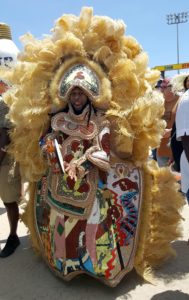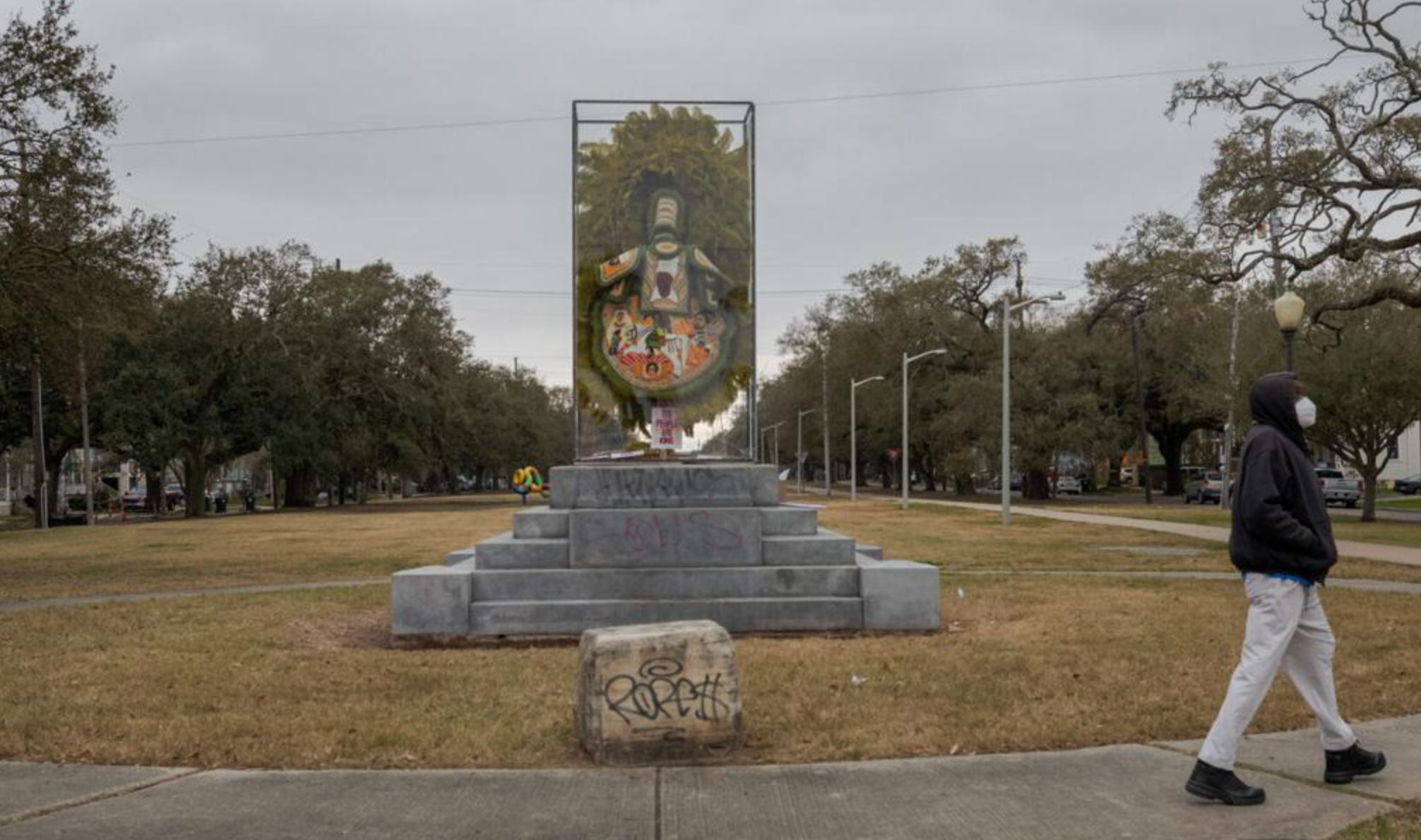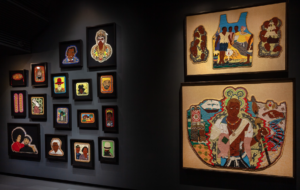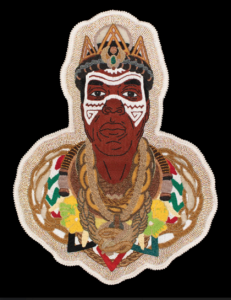Big Chief Demond Melancon of the Young Seminole Hunters has been taking it to the streets for decades as a part of the Black Masking Indian culture of New Orleans. He joins others in magnificent suits with beaded panels or patchs and huge dyed ostrich and turkey features for ritual gatherings on Mardi Gras morning, St. Joseph’s night and the “Super Sunday” parade held in the spring. But more recently his work has been appearing in art galleries and museums and he is becoming known in the art world internationally both through his Mardi Gras suits and his beaded portraits.

Demond Melancon made an appearance at the 2016 New Orleans Jazz & Heritage Festival in his Black Masking Indian suit, photo courtesy of Arthur Roger Gallery
Melancon currently has an exhibition on view at Arthur Roger Gallery, 432 Julia Street, through November 20. It is the latest of a series of group and solo shows of Melancon’s work hosted by the gallery. It features more than a dozen of his beaded portraits along with the apron and other panels from his 2016 suit he named after Bras-Coupé, an enslaved man who fled his captors in 18th-century Louisiana to lead a group of insurrectionists. Also on view is a nine-foot-tall 2020 Mardi Gras suit titled Jah Defender. Accompanying the display is a video of All on a Mardi Gras Day, an Academy Award-nominated documentary from 2019 that includes Melancon’s artistry.
The selected works exemplify the craft of beading that Melacon has mastered over many years, perfected through hundreds of hours of labor on intricate pieces. The beaded portraits include The Future and Now, a stunning image of African musician Fela Kuti, and images of artist Jean-Michel Basquiat, abolitionist Harriet Tubman and slave rebellion leader Nat Turner, among others.
Jah Defender features panels focusing on Rastafarian and Ethiopian traditions inspired by Haile Selassie and Empress Menen. Melancon wore the suit only once while leading the Young Seminole Hunters on Mardi Gras Day of 2020 before the pandemic shut down other appearances. When public gatherings were prohibited on Fat Tuesday in 2021, Melancon installed Jah Defender in a huge plexiglass on the bare pedestal on the neutral ground at the intersection of Canal Street and Jefferson Davis Parkway that formerly held a statue of the president of the Confederacy. The New Orleans City Council ordered the statute removed in 2017.
In the pre-dawn hours of that frigid Mardi Gras Day, Melancon and a group of friends installed the suit unannounced, and in so doing brought Mardi Gras to the people. Passersby and the news media were stunned. Its appearance was unexpected and unprecedented and drew immediate attention.

On Mardi Gras Day 2021, Demond Melancon’s Jah Defender suit was placed in a plexiglass case atop the pedestal that once held a statue of Confederate president Jefferson Davis, photo courtesy of Arthur Roger Gallery.
Throughout the day word spread of the installation on social media, drawing may curiosity seekers, including former mayor Mitch Landrieu, who had initiated the removal of Confederate monuments in the city. Melancon told reporters he wanted to celebrate those lost and those living. He believed that for this atypical Carnival, New Orleans needed to pay tribute to those lost from coronavirus.
“It represents love and happiness on a Mardi Gras Day!” said Melancon. He hatched the plan a month prior and worked with his friends in the Krewe of Red Beans and their leader, Devin DeWulf, constructing the plexiglass case and the making plans to transport the suit. The exhibition at Arthur Roger Gallery is the first chance for the public to behold Jah Defender since Mardi Gras.
Melancon’s work appeared in the contemporary craft area of the New Orleans Jazz and Heritage several years ago, which caught the eye of Arthur Roger.
“Immediately I asked him if he would do a show and I would help him,” said Roger. “We hit it off from the first moment.”
With the gallery’s support, Melancon has become better known in the art world. In 2017, one of his suits was in an exhibition in Chicago. The next year the artist was featured at Princeton University and the Museum of Contemporary African Diasporan Art in Brooklyn. In 2019, his work was exhibited in Manhattan, Art Miami, and was part of the London Design Festival in the Black Masking Culture exhibition at the Victoria and Albert Museum in London. Melancon recently ended a prestigious residency at the Joan Mitchell Center and was featured in the 2021 virtual Mardi Gras for All Y’All video series.
A beaded portrait of the late jazz musician Danny Barker was recently displayed at the LSU Museum of Art and is part of their permanent collection. In Memphis, a six foot beaded portrait of Isaac Hayes as Black Moses is on prominent display at the Central Station Hotel. The apron for his 2013 suit Ethiopia was sold at a recent Sotheby’s charitable sale to raise money for the Burning Man event. Three photos of Melancon masking on the streets are also part of the stunning exhibition Mystery in Motion: African American Spirituality in Mardi Gras at the Louisiana State Museum’s Presbytére in New Orleans through November 28. The exhibition’s companion website features an extensive interview with him.

The baedwork exhibition by Demond Melancon at Arthur Roger Gallery includes panels from the Bras-Coupé Black Masking Indian suit, at left, photo courtesy of Arthur Roger Gallery.
Black Masking Indians remain one of the strongest traditions within New Orleans’ African American community and in recent decades have become an iconic symbol for the city itself. Melancon masked for more than 15 years as Spy Boy for the Seminole Hunters. In 2012, he became head of his own tribe as the Big Chief of the Young Seminole Hunters.
For Melancon and many of his fellow Black Masking Indians, each suit must tell a story. He is interested in the history of the African diaspora and knows his family migrated to Louisiana from Haiti. “I study where we are coming from to know where we are going,” he said.
His 2016 suit Bras-Coupé focused on a 19th-entury enslaved person from the New Orleans area. The apron from the suit is featured on the cover of Bryan Wagner’s fascinating book, The Life and Legend of Bras-Coupé: The Fugitive Slave Who Fought the Law, Ruled the Swamp, Danced at Congo Square, Invented Jazz, and Died for Love.
Becoming a Black Masking Indian changed Melancon’s life and saved him. His father was not around and when things were dire, he sought out a local Big Chief who had become a father figure in his neighborhood. “I met Ferdinand Bigard of the Cheyenne Hunters and he taught me beading,” he said. “I went to all the practices. I started singing. I started learning from the elders about the culture.”
Every day, he sews beads onto canvas. He makes a new suit every year and each suit takes months—hundreds of hours of labor—from morning until night, as he says, “sewing and conjuring up the spirits.” Committed to continuing this tradition, he has also been teaching beading classes at the Material Institute, an experimental fashion school.
He is currently working on two pieces for a booth sponsored by Arthur Roger Gallery at the Art Miami 2021 exhibition in December. He continues working on his next suit hoping that indeed Mardi Gras 2022 will return to the streets.
For more information, visit the website for Arthur Roger Gallery.





